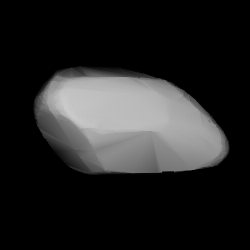 Shape model of Ishihara from its lightcurve | |
| Discovery [1] | |
|---|---|
| Discovered by | K. Endate K. Watanabe |
| Discovery site | Kitami Observatory |
| Discovery date | 16 April 1993 |
| Designations | |
| (9971) Ishihara | |
Named after | Takahiro Ishihara (Japanese astronomer) [2] |
| 1993 HS ·1991 YC2 1996 EU1 | |
| main-belt [1] [3] · Flora [4] | |
| Orbital characteristics [3] | |
| Epoch 4 September 2017 (JD 2458000.5) | |
| Uncertainty parameter 0 | |
| Observation arc | 24.91 yr (9,097 days) |
| Aphelion | 2.4465 AU |
| Perihelion | 1.9164 AU |
| 2.1814 AU | |
| Eccentricity | 0.1215 |
| 3.22 yr (1,177 days) | |
| 158.69° | |
| 0° 18m 21.24s / day | |
| Inclination | 2.7482° |
| 20.550° | |
| 246.01° | |
| Physical characteristics | |
| Dimensions | 4.986±0.053 km [5] 5.012±0.069 km [6] |
| 6.715±0.0036 h [7] 6.71574±0.00001 h [8] | |
Pole ecliptic latitude | (42.0°, 76.0°) (λ1/β1) [8] |
| 0.2328±0.0281 [6] 0.235±0.027 [5] | |
| S (assumed) [4] | |
| 13.7 [6] ·13.9 [3] ·13.852±0.006(R) [7] ·14.3 [4] | |
9971 Ishihara (prov. designation: 1993 HS) is a stony Flora asteroid from the inner regions of the asteroid belt, approximately 5 kilometers (3.1 miles) in diameter. It was discovered by Japanese amateur astronomers Kin Endate and Kazuro Watanabe at Kitami Observatory on 16 April 1993, [1] and named after Takahiro Ishihara, president of the astronomical society at Hiroshima. [2]
